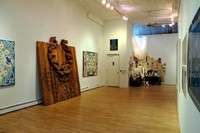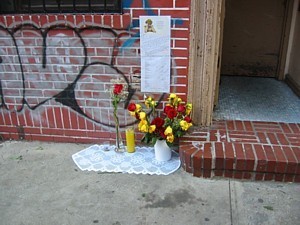

Anonymous: 9/11 Shrineat Ground Zero, 2001. (Photo: J.Perreault)
Where Were You?
Artist responses to 9/11 are, I suspect,as varied as lay responses. Defiance, withdrawal, denial, bewilderment. And good, old-fashioned anger. But somehow we expect artists to express their feelings in their work, whereas we do not ask the same of farmers, cable guys, nurses, clerks, engineers, and stockbrokers. Or philosophers.
On the other hand, everyone has a 9/11 story.
Herein I must relate my own moment of truth, to provide some context. I saw the first plane hit on television when I was about to get out of the door on my way to work. I am old enough to remember when an airplane hit the Empire State Building. Did I also see that on television — black and white — or only later in the Daily News?
In any case, on September 11, 2001, I thought: how weird, but I’d still better get to work. If the subway to Brooklyn is running I’ll continue on. After all, as the boss, I had better be there if there is any further emergency. I remember thinking, should I, as usual, stop at my gym at Bowling Green? I was already late. But the train mysteriously stopped dead at Bowling Green, which is at the tip of Manhattan. We were ordered to leave the cars. On the platform, there were weeping people lined up at the pay phone trying to reach…their offices or their loved ones? What was going on?
An announcement over the p.a. system, for once understandable, urged that we stay where we were, which was several levels beneath Bowling Green, never a pleasant prospect. And then in one of those moments of clarity, I smelled something acrid: burning wires. I was getting out of there no matter what; I was the first to mount the stairs. And then …
Suddenly I was in Alaska, except it wasn’t cold. Everything was covered with inches of white ash, and I saw ash-covered zombies in ash-covered business suits parading by, through the ash-covered streets. They had no race; everyone was white. A bullhorn urged that we walk east and then follow the river. I too pulled out my undershirt from under my now-untied tie and my starched shirt to cover my nose and my mouth.
Further east the air cleared, and I was treated to the spectacle of business folk first cursing their cell-phones then banging them and sometimes smashing them on any available surface. Suddenly, not quite at the Fulton Street Seaport, people were running down an alley toward me; a World Trade tower looming above them in the not so distant distance: They were screaming:It’s going! The second one is coming down!
In the quickestmath I have ever used, my brain instantly compared the height of the tower and my distance from the base. Not knowing that the first tower had imploded, I pictured the tower toppling like a giant tree and landing on top of me. I ran, my snowstorm trance broken,
Next I saw tiny silhouettes, as if in a Roger Brown painting, crossing over to Brooklyn on the Brooklyn Bridge. Coming to my senses, I decided that hiking back home to the East Village would be wiser than trudging over the East River to downtown Brooklyn, where my workplace was. So much for my unexpected “captain of the ship” syndrome. If trapped, could I bear an Urbanglass sleepover?
Second Avenue, when I finally got there, was eerie. The silence was so thick you could cut it with a bread knife. Except there was already almost no bread in the supermarket or any of the convenience stores. (I did find a last square package of organic pumpernickel in the 9th Street Indian-run all-night place. Even the threat of starvation would not get anyone but me to grab that particular rock.) All the milk had gone missing, too. Tells you something, right? Bread and milk before steak and eggs, before booze and butter.
My beloved was in Philadelphia, and how we finally regained contact is another story. But somehow we did. He wrote his end of the tale for the Philadelphia Inquirer.
And now, much later, it’s clear my life was changed. Good-bye day job; hello blog. Good-bye arts administration, hello art. Goodbye magazine editing; hello poetry. This is, of course, a simplification, but it is the truth. It took a while and some sleight-of-hand to work myself free, but within a year I was in the clear.

Installation View: The Art of 9/11 at apexart
Just A Few Friends
Now perhaps we are far enough away to look at some art. Or obviously so, thinks philosopher/art critic Arthur Danto. His “The Art of 9/11” at apexart (291 Church St., to Oct. 15) gathers a few works made by artists right after 9/ll. I like Robert Rahway Zakanitch’s “decorative” paintings, because he is the best paint handler, abstract or not, now going. And as much as we hate clowns, we love Cindy Sherman done up as one, sensing that she, like Bruce Nauman — and yours truly — hates and fears clowns too.
This is not a show of memorial art. That’s a whole other subject. It is instead, I think, an exhibition of the adjacent. The deep question here is not so much how art can memorialize, but how we discern meanings and intentions without the apparatus of the verbal. In Danto’s exhibition this becomes the subject. He has grouped together what some of his artist acquaintances made immediately after 9/11, thus foregrounding a problematic.
In trying to parse works by Lucio Pozzi and also Audrey Flack, works that have no obvious connection to 9/11 (Flack offers watercolors of fishing boats in Montauk Harbor), you have to read their statements, which are mostly 9/11 stories. Danto admits: “That is how it is with religious acts. One has to know the spirit in which they are performed to grasp their cultural meaning.” In fact, some works do have a visible relationship to the event: Barbara Westman’s Memory Piece, a depiction of the memorial light towers (to my mind now the only 9/11 memorial we really need), and Leslie King-Hammond’s altar. Mary Miss’s Moving Perimeter: A Wreath for Ground Zero, once the subtitle is removed, could be an outdoor artwork anywhere for any purpose. Pozzi actually showsphotographs of 9/11 smoke on Mulberry Street, and Jeffrey Lohn rephotographed photographs of the missing posted after the catastrophe.
Danto, however, is particularly eloquent here and, closer to 9/11, in The Nation in his understanding of the spontaneous altars that were created around the city right after 9/11. Some, as on my block, reappear at every 9/11 anniversary: words, candles, and flowers. Unlike most art, they allow no ambiguity. My question is: Are they then really art?
Nevertheless, Danto’s phrase “the spirit in which they are performed,” offered up in conjunction with his collection of post-9/11 art, is suspiciously like rooting out intentions. We in literature have long been warned of the intentional fallacy.
I would rephrase the issues in the following way. What is the form of grief? What is the color of anger? We need to turn the problem inside-out. Isn’t the spiritual part of religious art the making of that art? Is there a technology of the spirit that utilizes the visual?
What holds art back? Fear. Fear of sentiment (or emotion). Fear of producing propaganda. Fear of being pinned down: your opinions may one day be used against you. Not having the right vocabulary to express outrage, grief, fear. Or: dismay.
Artist responses in Danto’s show seem to be one species or another of “life — i.e. art; my art — must go on.” Does this mean that art at some very deep level means hope? Yes. Is art therefore a faith in the future, or a magical effort to assure there will be a future? Yes, up to a point, but I don’t think this means that if there were no future, artists would stop making art. Art-making is about confirming the present, too, and making it sacred or revealing it as such, no matter what.
* * *
Another 9/11 exhibition takes a more traditionally activist approach: the Lower Manhattan Cultural Council’s “A Knock at the Door” (at Cooper Union, Astor Place; and the South Street Seaport Museum, to Oct. 1). Here, as in Danto’s show, the viewer needs to do a lot of reading: anonymous boxes stenciled with the phrase “Fear Art” at both sites work; as dobanners at the Seaport Museum showing persons abused in one way or another by the Patriot Act and its atmosphere of fear.
We know — or should know — the Steve Kurtz story. Kurtz is a member of the extremely serious and Artopia-approved Critical Art Ensemble. When he called the police to let them know his wife had just died of a heart attack, he was arrested for bioterrorism. Why? One Critical Art Ensemble theme has been genetic alteration of plants. And somehow the officials in charge thought Kurtz — apparently already under survaillance –was making a biological weapon. One entry in this extremely inclusive exhibition is a replication of Kurtz’s books seized by the FBI.
Danto’s exhibition is, curiously enough, about reaffirming art’s importance even when there is an apparent withdrawal from the world; curator Seth Cameron’s “A Knock at the Door…” is a reaffirmation instead of the values those behind the 9/11 culprits were hoping to destroy. Freedom of speech is anathema to dictatorships of all kinds. Abuses of the Patriot Act, alas,aid their cause. Why U.S. government agencies time and again fasten on artists is beyond me. Is it that artists are always under suspicion, are weak? Are dangerous? Not the ones I know. A reminder: we have rules and laws not only to protect ourselves from each other, but to protect ourselves from our government. Others are not so lucky.
Arthur Danto’s essay is online at apexart.org. Statements by the artists are available at the gallery only.
Seth Cameron’s autobiographical and extremely clever essay is part of the LMCC handout, which also includes advice from the American Civil Liberties Union: Know Your Rights: What to Do If Questioned by Police, FBI, Customs Agents or Immigration Officers.

Anonymous: East Village 9/11 Shrine, 2001-05. Photo: J.Perreault
